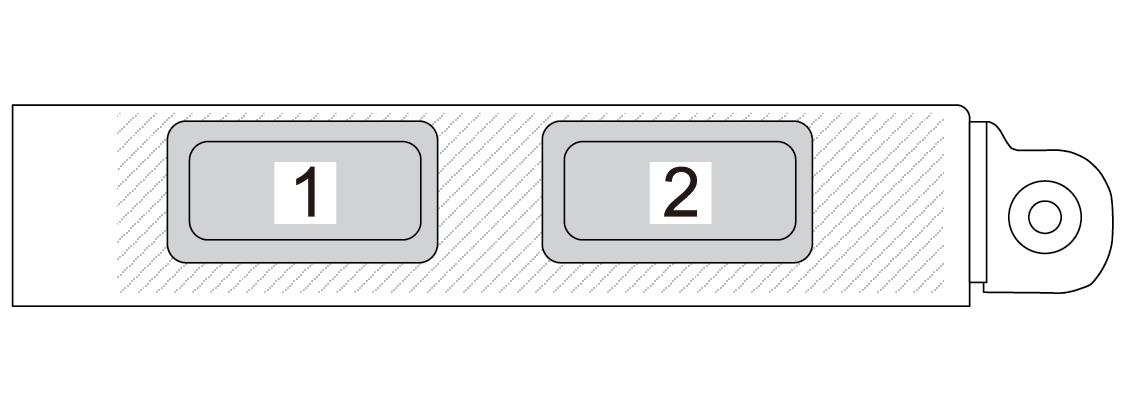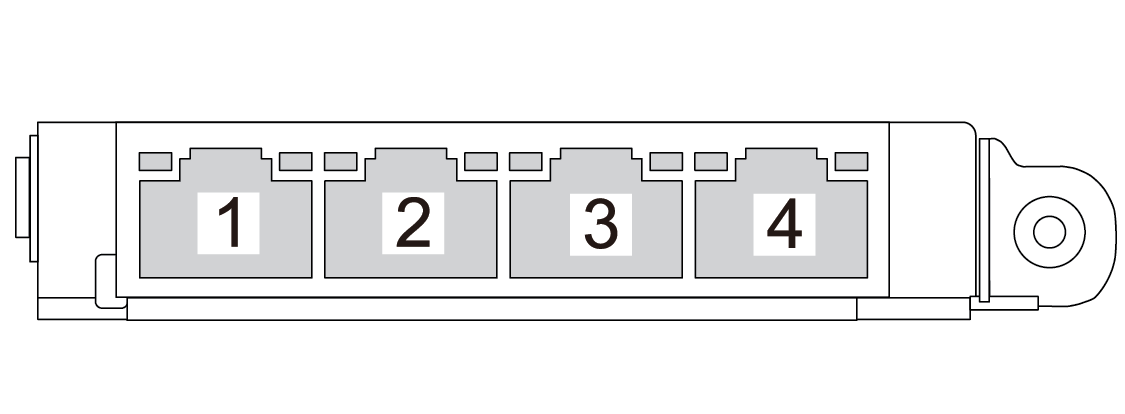Rear view
The rear view of the server varies by model. Depending on the model, your server might look slightly different from the illustrations in this topic.
Server model with three PCIe slots

| Callout | Callout |
|---|---|
| 1 PCIe slot 1 on riser 1 assembly | 2 PCIe slot 2 on riser 1 assembly |
| 3 PCIe slot 3 on riser 2 assembly | 4 Power supply 2 (optional) |
| 5 Power supply 1 | 6 NMI button |
| 7 USB 3.2 Gen 1 (5Gbps) connectors (3 DCIs) | 8 VGA connector |
| 9 XClarity Controller network connector | 10 Ethernet connectors on OCP module (optional) |
Server model with two PCIe slots

| Callout | Callout |
|---|---|
| 1 PCIe slot 1 on riser 1 assembly | 2 PCIe slot 2 on riser 1 assembly |
| 3 Power supply 2 (optional) | 4 Power supply 1 |
| 5 NMI button | 6 VGA connector |
| 7 USB 3.2 Gen 1 (5Gbps) connectors (3 DCIs) | 8 XClarity Controller network connector |
| 9 Ethernet connectors on OCP module (optional, two or four connectors may be available) |

| Callout | Callout |
|---|---|
| 1 PCIe slot 1 on riser 1 assembly | 2 PCIe slot 3 on riser 2 assembly |
| 3 Power supply 2 (optional) | 4 Power supply 1 |
| 5 NMI button | 6 VGA connector |
| 7 USB 3.2 Gen 1 (5Gbps) connectors (3 DCIs) | 8 XClarity Controller network connector |
| 9 Ethernet connectors on OCP module (optional, two or four connectors may be available) |
Server model with two 2.5-inch hot-swap rear drive bays and one PCIe slot

| 1 PCIe slot 1 on riser 1 assembly | 2 Rear 2.5-inch drive bays (2) |
| 3 Power supply 2 (optional) | 4 Power supply 1 |
| 5 NMI button | 6 VGA connector |
| 7 USB 3.2 Gen 1 (5Gbps) connectors (3 DCIs) | 8 XClarity Controller network connector |
| 9 Ethernet connectors on OCP module (optional, two or four connectors may be available) |
Server model with two 7mm hot-swap rear drive bays and two PCIe slots

| 1 PCIe slot 1 on riser 1 assembly | 2 PCIe slot 2 on riser 1 assembly |
| 3 Rear 7mm drive bays (2) | 4 Power supply 2 (optional) |
| 5 Power supply 1 | 6 NMI button |
| 7 USB 3.2 Gen 1 (5Gbps) connectors (3 DCIs) | 8 VGA connector |
| 9 XClarity Controller network connector | 10 Ethernet connectors on OCP module (optional, two or four connectors may be available) |
Server model with two 7mm hot-swap rear drive bays and one PCIe slot

| 1 PCIe slot 1 on riser 1 assembly | 2 Rear 7mm drive bays (2) |
| 3 Power supply 2 (optional) | 4 Power supply 1 |
| 5 NMI button | 6 VGA connector |
| 7 USB 3.2 Gen 1 (5Gbps) connectors (3 DCIs) | 8 XClarity Controller network connector |
| 9 Ethernet connectors on OCP module (optional, two or four connectors may be available) |
Server model with two PCIe slots and a direct water cooling module

| 1 PCIe slot 1 on riser 1 assembly | 2 Hose holder |
| 3 Inlet hose | 4 Outlet hose |
| 5 PCIe slot 3 on riser 2 assembly | 6 Power supply 2 (optional) |
| 7 Power supply 1 | 8 NMI button |
| 9 USB 3.2 Gen 1 (5Gbps) connectors (3 DCIs) | 10 VGA connector |
| 11 XClarity Controller network connector | 12 Ethernet connectors on OCP module (optional, two or four connectors may be available) |
Rear components overview
Ethernet connectors
Figure 4. OCP module (two connectors)  | Figure 5. OCP module (four connectors)  |
The OCP module provides two or four extra Ethernet connectors for network connections.
By default, any Ethernet connector on the OCP module can also function as a management connector using the shared management capacity.
Hot-swap drives and drive bays
The drive bays on the front and rear of your server are designed for hot-swap drives. The number of the installed drives in your server varies by model. When you install drives, follow the order of the drive bay numbers.
The EMI integrity and cooling of the server are protected by having all drive bays occupied. Vacant drive bays must be occupied by drive fillers.
PCIe slots
The PCIe slots are on the rear of the server and your server supports up to three PCIe slots on riser 1 and 2 assemblies.
Power supply units
The hot-swap redundant power supply helps you avoid significant interruption to the operation of the system when a power supply fails. You can purchase a power supply option from Lenovo and install the power supply to provide power redundancy without turning off the server.
On each power supply, there are three status LEDs near the power cord connector. For information about the LEDs, see System LEDs and diagnostics display.
USB 3.2 Gen 1 (5Gbps) connectors
The USB 3.2 Gen 1 (5Gbps) connectors are direct connect interfaces (DCIs) for debugging, which can be used to attach a USB-compatible device, such as a USB keyboard, USB mouse, or USB storage device.
VGA connector
The VGA connectors on the front and rear of the server can be used to attach a high-performance monitor, a direct-drive monitor, or other devices that use a VGA connector.
XClarity Controller network connector
The XClarity Controller network connector can be used to attach an Ethernet cable to manage the baseboard management controller (BMC).
Rear LEDs
For more information about the LEDs on the XCC system management port, see LEDs on the XCC system management port.
For more information about the system error LED and system ID LED, see LEDs on the system board assembly.
For more information about the LEDs on the power supply unit, see LEDs on the power supply unit.
Inlet and outlet hoses
The Direct Water Cooling Module (DWCM) spreads two hoses out to connect to the manifolds. The inlet hose conveys warm water from the facility to the cold plates to cool down the processors, and the outlet hose conducts hot water out of the DWCM to realize system cooling.